Both companies finish the year on a high note /// Airbus breaks three industry records


Boeing and Airbus reported strong orders and deliveries figures in December 2023 and finished the year on a high note. Airbus just set three new industry records last month: Backlog record (8,598 jets), highest gross orders in a year (2,319 jets), and highest net new orders in a year (2,094 jets). Also, Boeing set a new company all-time backlog record (6,216 jets). These records are signs of things to come. In a few years, Airbus will be the first commercial jet maker to report 1,000 deliveries in a single year, and, at the same time, the rivalry between the two major commercial jet makers will intensify, as Boeing will do its utmost to close the gap to its European rival.
In December, Boeing delivered 67 commercial jets compared to Airbus with 112 units. This compares to 69 deliveries for Boeing and 98 for Airbus in December of last year. In 2023, in total, Boeing and Airbus delivered 528 and 735 aircraft compared to 480 and 663, respectively, in 2022. In 2023, Airbus won the deliveries crown for the fifth consecutive year.
Following a more than challenging 2020 due to the COVID-19 pandemic, 2021-23 were recovery years for the two largest commercial plane makers. Boeing still has quite a way to go before setting new all-time company deliveries records, whereas Airbus could be back to pre-pandemic levels already next year. In 2018, before COVID-19 and the first 737 MAX grounding, Boeing delivered 806 jets, a level that will likely not be recaptured before the 2025-26 timeframe. Airbus’ record high of 863 shipments was set in 2019, a level that could be surpassed in 2024 if the supply chain can keep up. Also, Airbus is expected to retain its delivery lead for the foreseeable future due to the company’s comfortable backlog lead over its American rival. Before 2019, Boeing had out-delivered Airbus every year since 2012.
As indicated above, in December 2023, Boeing delivered 67 jets, including 45 737s (44 MAXs / 1 NG), seven 767s, four 777s, and 11 787s. The 737 MAX program had some catching up to do after a manufacturing issue discovered in August last year negatively impacted aircraft deliveries for several months. However, Boeing’s numbers came roaring back in November and December. Since June of last year, the 737 program was producing aircraft at an official rate of 31 per month. The program has now completed the transition to 38 aircraft per month, although nothing has officially been announced. At their Q3 earnings call, Boeing announced that they expected the transition to be completed by the end of 2023. At the same time, Boeing reduced their 2023 guidance from 400-450 737 MAX deliveries for the year to 375-400, due to required rework to remedy the aforementioned 737 MAX production defect. With 387 737 MAXs delivered in 2023, numbers came in right in the middle of the 375-400 range. In the long term, Boeing expects to increase production to approximately 50 737 MAX jets per month in the 2025/26 timeframe. We can therefore expect increases well above 38 jets per month this year. The target of 50 per month compares to the pre-crash/pre-pandemic rate of 52 737s per month in 2018. Recently, it was reported that the company is planning to boost production to 52 jets per month by January 2025. Boeing will open a new 737 MAX production line in Everett in the second half of 2024. The new line is in addition to the three lines currently in place in Renton. Boeing ended the third quarter with 250 737 MAX jets in inventory, up 22 from Q2 2023. Customers in China account for 85 of these aircraft. Boeing expects most of the inventoried jets to be delivered by the end of 2024. The company is still producing 737 NGs but now only has 16 737-800s remaining in backlog.
In August 2022, deliveries of the Boeing 787 Dreamliner were resumed following a suspension of shipments that lasted nearly 16 months. Boeing had suspended Dreamliner deliveries in May 2021 for the second time in less than a year. In June 2023, the 787 production rate was raised to four per month and the program is currently transitioning to a rate of five, followed by further increases before reaching 10 aircraft per month by 2025/26. Boeing ended the third quarter with 75 Dreamliners in inventory, down 10 from Q2 2023.
The 747 program closed down production when the last aircraft was delivered to Atlas Air in January 2023. The 767 program is currently producing jets at a rate of three units per month, a mix of KC-46 tankers (based on the 767-2C) and 767-300 freighters. The 777 program is currently pushing out aircraft at a rate of three per month. Most aircraft in backlog are 777 freighters, with only five 777-300ERs left. The 777 program was expected to get a new addition in late 2023 with the first delivery of the 777X, but in the spring of 2022, Boeing announced this will now not happen before 2025. In 2022, Boeing launched a new 777X-based freighter, thereby expanding its 777X and cargo portfolio. By the 2025/26 timeframe, Boeing expects to be delivering four 777s per month.
Airbus has a tradition of finishing the year with very high deliveries numbers, and the last month of 2023 was no exception. In December, Airbus delivered as many as 112 jets, including 11 A220s, 81 A320s (all NEO), six A330s, and 14 A350s. The official A320 production rate is 45 aircraft per month and has remained at this level since the end of 2021. On average, the company delivered 48 A320s per month in 2023 compared to 43 in 2022. Production is currently being increased and an official rate hike is coming soon. In connection with the release of their 2023 full-year earnings in February, we can expect the A320 rate to be officially raised. At this time, we consider the unofficial A320 production rate to be 48 per month but will keep the rate in our charts and tables at 45 for now. The A320 program is expected to reach a monthly rate of 65 by late 2024. We can therefore expect a series of rate increases this year. Also, Airbus is working with its supply chain to increase A320 production to 75 aircraft per month in 2026. The A321XLR flight test program is reportedly progressing well, and entry into service is expected to take place in the second quarter of 2024.
The A220, meanwhile, is being produced at a rate of six aircraft per month, with a monthly production rate of 14 expected by 2025. We also expect Airbus to increase the official A220 rate soon. Airbus is currently considering launching a stretch version of the A220, which many now refer to as the “A220-500” or even “A221.” Currently, the Pratt & Whitney PW1500G is the only engine option for the A220, and the new variant will most likely come with a second engine option.
The A330 production rate was increased from two aircraft per month to three at the end of 2022, with an increase to four per month expected this year. The A350 production rate was raised to six per month at the end of 2023 in line with Airbus’ announcements. Airbus expects to produce nine A350s per month by 2025.
Turning to the December orders review, Boeing had an extremely strong month. The company booked orders from eight customers for a total of 371 jets (gross orders) and reported two 787 cancellations, resulting in an impressive 369 net new orders. The December orders haul was dominated by a large 737 MAX order for 156 aircraft placed by an undisclosed customer. The second largest booking, for 45 787-9 Dreamliners, was also placed by an undisclosed customer, followed by an order placed by Turkey’s SunExpress Airlines, a joint venture between Turkish Airlines and Lufthansa, for 45 737 MAX jets (28 737-8s and 17 737-10s). The SunExpress order was announced at Dubai Airshow 2023 in November of last year. Other significant December orders were placed by Ireland-based international leasing firm Avolon (40 737 MAX), Lufthansa (40 737 MAX), and Ethiopian Airlines (20 737 MAX and 11 787-9). In 2023, Boeing booked a total of 1,314 net new orders (1,456 gross orders) – before ASC 606 changes – compared to 774 net new orders (935 gross orders) in 2022. Please note that for comparison reasons, we do not include Boeing’s so-called ASC 606 accounting adjustments in the numbers reported in this article and regard net new orders as gross orders minus cancellations.
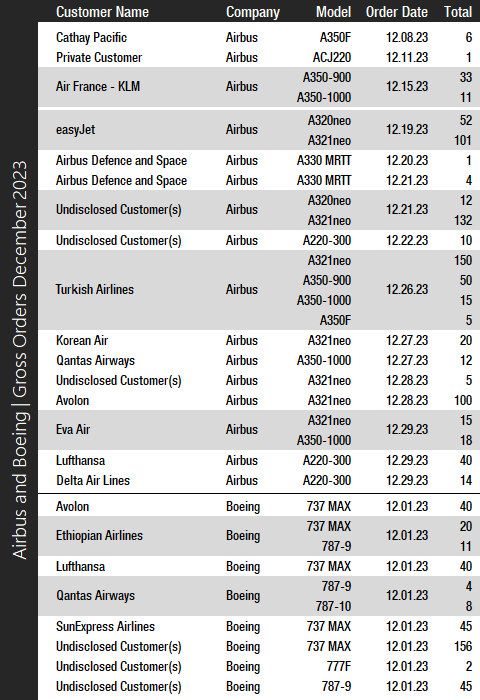
In December, Airbus had a wild month and received orders for 807 jets (gross orders) from 16 different customers and reported 108 cancellations (seven A320ceos, seven A321ceos, 34 A320neos, eight A330-200s, eight A330-300s, 28 A330-900s, and 16 A350-1000s), for a total of 699 net new orders. Turkish Airlines, placed a massive order for 220 jets comprised of 150 firm A321neos and 70 firm A350s (50 A350-900s, 15 A350-1000s, and 5 A350F freighters). The order takes Turkish Airlines’ total orderbook for Airbus aircraft to 504, of which 212 have been delivered. Just before the Dubai Airshow in November last year, Turkish state-run Anadolu news agency announced that Turkish Airlines and Airbus were nearing a huge purchase of 355 aircraft, including 250 A321neos. In a Turkish Airlines press release dated December 18, the order was also presented as 355 jets in total including commitments, however, Turkish Airlines is reporting 80 firm A350s vs. the 70 in Airbus’ December 15 press release. While 220 aircraft is a massive number, it falls well short of the current industry records. For example, at the Paris Air Show last year, Indian carriers IndiGo and Air India placed orders with Airbus and Boeing for 500 and 470 jets, respectively.

Also in December, major UK-based low-cost carrier, easyJet, placed a firm order for 153 A320neo family aircraft comprised of 52 A320neos and 101 A321neos. The order also includes the upsizing of an existing order for 35 A320neos into the larger A321neo model. The third largest order was placed by an undisclosed customer for 12 A320neos and 132 A321neos, followed by Avolon, which booked 100 A321neo jets. Also, Air France – KLM placed a large widebody order for 33 A350-900s and 11 A350-1000s ahead of Lufthansa’s order for 40 A220-300s, and Taiwan’s Eva Air, which booked 15 A321neos and 18 A350-1000s. Other significant orders include Korean Air’s order for 20 A321neos, Delta Air Lines (14 A220-300), Qantas Airways (12 A350-1000s), an undisclosed customer’s order for 10 A220-300s, and finally, Airbus Defence & Space’s orders for a total of five A330 MRTT tankers. In 2023, Airbus won the orders crown for the fifth consecutive year booking an astounding 2,094 net new orders (2,319 gross orders), compared to 820 net new orders (1,078 gross orders) in 2022.
At the end of December, Airbus reported a new industry backlog record of 8,598 jets, of which 7,797, or 91 percent, were A220 and A320ceo/neo family narrowbodies. Airbus’ old record was set in August 2023 when the company reported a backlog of 8,024 jets. By the end of last month, Boeing’s backlog (total unfilled orders before ASC 606 adjustment) was 6,216 aircraft (a new company record – Boeing’s former backlog record of 5,964 aircraft was set in August 2018), of which 4,799, or 77 percent, were 737 NG/MAX narrowbody jets. The number of Airbus aircraft to be built and delivered represents 10 years of shipments at the 2019 production level (the pre-pandemic level), or 11.7 years based on the 2023 total. In comparison, Boeing’s backlog would “only” last 7.7 years at the 2018 level (the most recent “normal” year for Boeing), or 11.8 years based on 2023 deliveries. Boeing’s book-to-bill ratio last year, calculated as net new orders divided by deliveries, was 2.49 with Airbus coming in even higher at 2.85. This means that both companies received well over two new firm orders for every aircraft delivered. In 2022, Boeing’s book-to-bill ratio was a very strong 1.61. Meanwhile, Airbus’ book-to-bill ratio was a solid 1.24.
2024 Forecast
Forecast International’s Platinum Forecast System is a breakthrough in forecasting technology that provides 15-year production forecasts. The author has used the Platinum Forecast System to retrieve the latest delivery forecast data from the Civil Aircraft Forecast product. For 2024, Forecast International’s analysts currently expect Boeing and Airbus to deliver 633 and 852 commercial jets, respectively. Please note that these figures exclude militarized variants of commercial platforms such as Boeing’s P-8 Poseidon maritime patrol aircraft and KC-46 Pegasus tanker and Airbus’ A330 MRTT tanker.
Boeing released its Q4 2023 and full-year results on January 31. Given the company’s current focus on strengthening quality in the aftermath of the Alaska Airlines Flight 1282 incident, Boeing will not be issuing 2024 guidance for now. Airbus will release full-year 2023 results and provide guidance on 2024 deliveries on February 15.
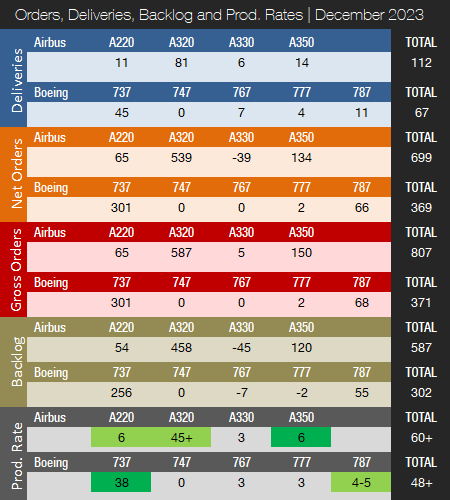
Note: Light green color for production rates means the program is currently transitioning to a higher rate. Green color means the rate has just been increased.
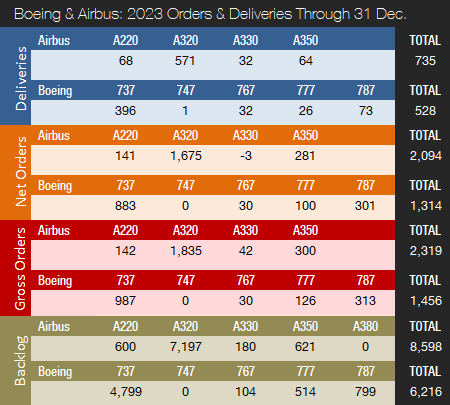
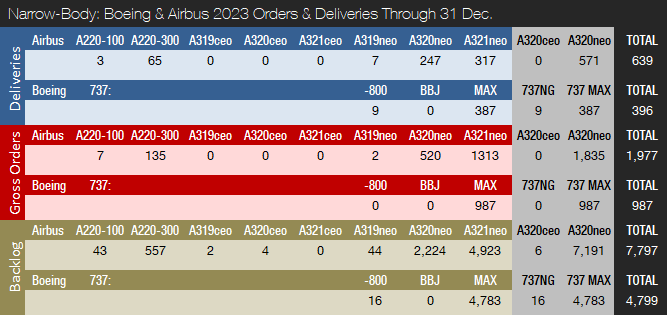
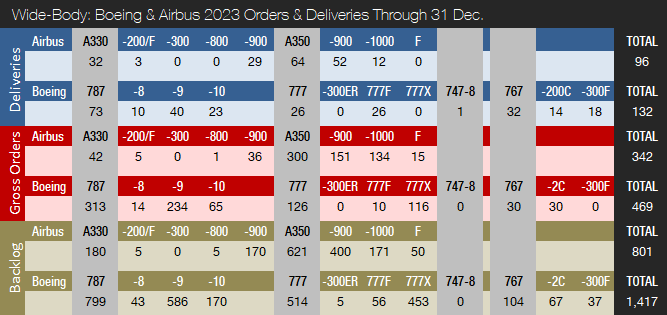
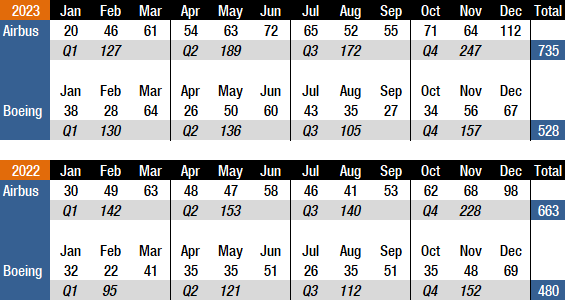
References:
- https://www.forecastinternational.com/platinum.cfm
- http://www.boeing.com/commercial/#/orders-deliveries
- https://www.airbus.com/aircraft/market/orders-deliveries.html
- https://www.airbus.com/en/newsroom/press-releases/2024-01-airbus-reports-strong-2023-commercial-aircraft-orders-and
- https://boeing.mediaroom.com/news-releases-statements?item=131389
- https://flightplan.forecastinternational.com/2023/12/22/airbus-running-up-the-orders-score-with-slew-of-december-bookings/
Kasper Oestergaard is an expert in aerospace & defense market intelligence, fuel efficiency in civil aviation, defense spending and defense programs. Mr. Oestergaard has a Master's Degree in Finance and International Business from the Aarhus School of Business - Aarhus University in Denmark. He has written four aerospace & defense market intelligence books as well as numerous articles and white papers about European aerospace & defense topics.



